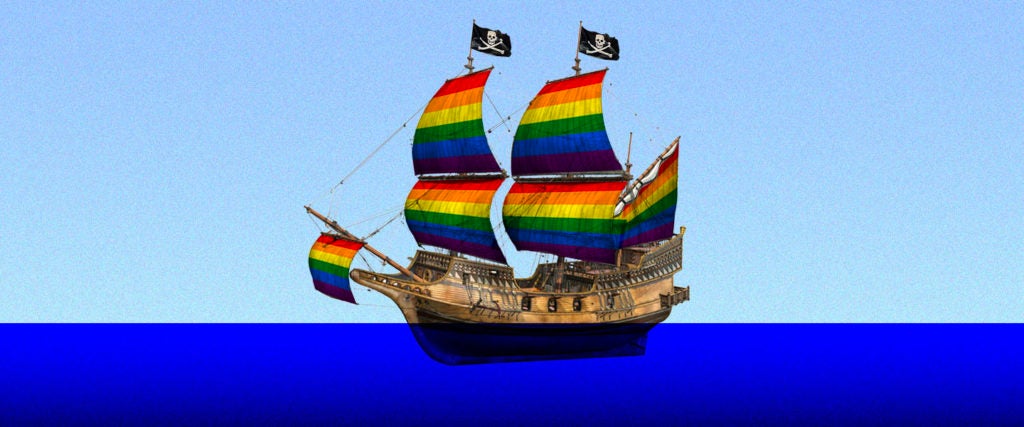You know pirates, yeah? Well, they’ve always been super gay.
It’s generally established that the Golden Age of Piracy lasted from the 1650s to the 1730s. Back then, homosexuality was seen as something you did rather than who you were, and the practice wasn’t exactly accepted on land. To reflect this accurately, historians used the term “sodomy” — a legal definition that described everything from gay male butt-fucking to literal bestiality — to describe the all “immoral,” non-reproductive, unmarried sex people were having.
But out at sea, things were different. Though we know pirates as macho, swashbuckling stereotypes and eye patch-wearing gangsters, they were mostly just horny loners stuck out on the water, where they were free to make their own rules. Naturally, they found plenty of ways to keep each other company, and as such, historians have identified a handful of sodomites amongst them.
There’s little information about the nitty-gritty of pirate’s sex lives, but there is a holy grail text about sodomy on their ships. In the 1983 book Sodomy and the Pirate Tradition, author B.R. Burg made a few pretty substantial claims. “Homosexual acts were the only form of sexual expression engaged in by members of the buccaneer community,” he wrote. (“Buccaneer” is a specific term for hunter pirates in the Caribbean during the late 17th century.) “Amongst the pirates of the Caribbean, communities could evolve and mature with little or no interference from a dominant, restrictive and sometimes hostile heterosexual nation.”
Burg also notes that sodomites of the time were drawn to the seas, where “homosexual preferences were common and opportunities for heterosexual contact were few or entirely absent.” Not all of these seamen chose this lifestyle — plenty were “pressed” sailors captured against their will — but the oceans of the world were seemingly packed with men whose desires would get them locked up on the mainland.
Arguably the most famous of the sodomite pirates was Captain Bartholomew Roberts, known for his wildly lucrative ship hauls. He was so keen to get off on-board that he famously introduced a Pirates’ Code, one clause of which banned women and boys from the ship. “If any man were to be found seducing any [woman] and carried her to sea, disguised, he was to suffer death,” the code stated.
After making his feelings on heterosexuality pretty clear, Roberts allegedly started an affair with a volunteer surgeon named George Wilson. After being separated for five months, they reunited by chance on another ship — accounts state Wilson was “very alert and cheerful” to see his lost beau, and even borrowed “a clean shirt and drawers” to look his best for the meeting. There are no literary porn scenes in pirate history — details of pirates’ daily lives are hard to come by, and sex was discussed way less frequently in the 17th century — but it’s pretty safe to assume these guys were more than just friends.
Tracking down other famous gay pirates is trickier. There’s a figure named Pierre — Pierre the Pansy Pirate, as he’s best-known, although the scarcity of sources on his life means some argue he didn’t actually exist — who reportedly owned a coffee shop, a hairdressing salon and a dressmakers’ shop, apparently enough to earn his “pansy” reputation. This poor dude was one of the first gays to be relegated to the “gay best friend” role — he’s mentioned only briefly in accounts of Anne Bonny, a woman who cross-dressed as a man in order to work at sea. The one existing painting of Pierre shows him with a flouncy shirt, an impressive blond mustache and a flower-adorned top hat (but it’s likely his queerness has been embellished by thirsty gays hungry for historical representation).
There’s also a legitimate argument to be made that pirates were amongst the first communities to practice same-sex marriage, specifically in a ritual called matelotage. Burg describes it as “an institutionalized linking of a buccaneer and another male — most often a youth — in a relationship with clearly homosexual characteristics.” This civil union looked different for everyone. Some used it to strengthen their bonds with platonic companions; others saw it as an economic insurance policy.
A famous example of matelotage was between Richard Baker and Olauduh Equiano, a former slave who fell in love with Baker, a white, slave-owning American. There’s no confirmation they had sex, but for two years, they “shared the same bed space and confided in one another with personal troubles.” According to Equiano, these guys spent long nights “lain in each other’s bosoms [during times of] great distress.”
Even the best modern portrayals of pirates have been pretty gay. Johnny Depp’s wacky, flamboyant Jack Sparrow left Disney execs wondering whether he was “drunk or gay” — or both — and Hook had enough gay subtext to warrant entire essays about the supposed romance between Captain Hook and Smee. Historians and podcasters are increasingly queering their analyses of these macho maritime bros, too.
Homoerotic unions like these add to the lore of pirates as proto-gay icons, and, like it or not, the gays have thoroughly claimed pirates as kin. They may or may not have been boning on-board, but that’s okay — there’s still a fair amount of evidence that these bearded bandits enjoyed their fair share of seamen.

